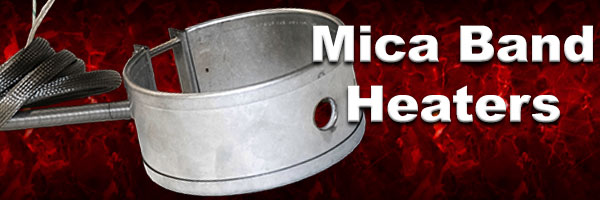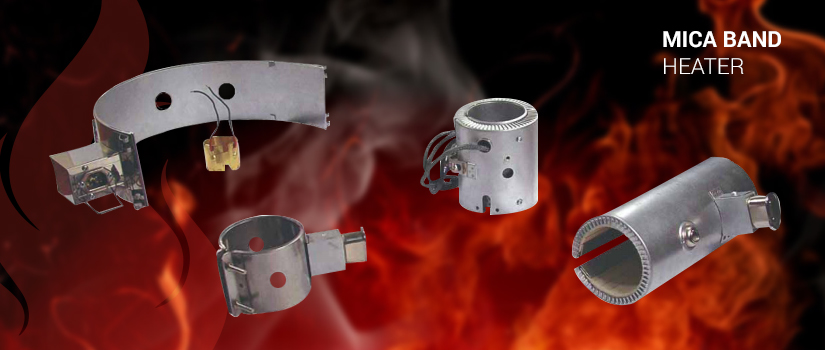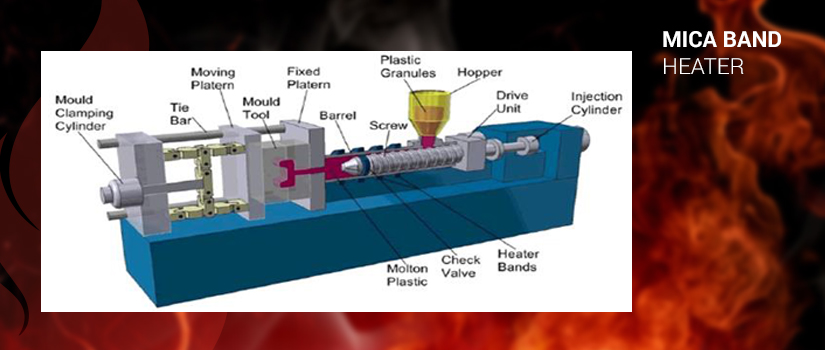MICA BAND HEATER- [MBH]
Mica Band Heaters are our most widely used band heater because of their versatile design and rugged construction characteristics. Mica Bands have sheath temperature:
- Plastics Injection Molding
- Extrusion
Blow Molding applications as well as in Commercial Cooking, Dies and Electric Motors.
Construction
HSCO-MICA band heaters are manufactured to your specifications. Only the highest quality materials are used for optimal performance.
- High temperature oxidation resistant metal sheath. Upto 425 Deg [800°F]
- Highest grade mica insulation provides excellent electrical insulation at high temperatures and is resistant to moisture.
- Clamping band is low thermal expansion stainless steel construction designed to main clamping pressure at elevated temperatures.
- Nickel/Chromium resistance wire evenly would for uniform heat distribution and reliable accuracy.
- To ENQUIRY / ORDER, follow the chart / request form

Standard Configurations
HSCO designs and manufactures mica band heaters. Each mica band heater is manufactured to your specifications and can be shipped as quickly as many off the shelf heaters, when needed. Mica band heaters are used to heat cylinders such as the barrels and nozzles of plastic injection and extruding machines.
- High watt-density capabilities
- Reasonably high temperature capabilities- 800°F
- Good efficiency
- Good lifetime
- Low cost
Determine the diameter of the part you want to install the heater on.
.jpg)
Hopefully, you can get this information from a drawing, but if not, you can refer to the above graphic and easily make your own measurement (We only need one of the dimensions). Next, determine the width of the heater and the length of the lead wire if appropriate.
After that, specify the wattage and the available voltage and you are ready to go! If there are holes or notches in your band heater.
Check Your Barrel Or Nozzle Surfaces
When replacing a mica band heater assure that the barrel or nozzle is free of material, smooth and clean.
.jpg)
A rough spot or foreign material on the barrel can greatly reduce the life of your mica band heater. A small particle can leave an air gap on either side of itself which can cause a “hot spot.” Air will not conduct the heat away from your heater as fast as the metal of the barrel. This results in a spot on the heater where the temperature will be significantly hotter than the rest of the heater. Just a 0.005″ air gap on a typical 30 watts per square inch heater will cause that spot to run 250 degrees (F) hotter!
The Tighter, The Better
After installing a new mica band heater, we suggest that you come back to it after fifteen minutes of operating time. After proper actions are taken to assure there is no power going to the heater and that the heater will not cycle on, re-tighten your straps or clamping mechanism.
Make a habit of checking the tightness of the band heater periodically and you will be surprised at how you can increase the life of your band heaters.
Fewer Holes, Longer Life
Every time you add a hole to a mica band heater, you give another avenue for Contaminants to enter the heater.
If the hole is for a thermocouple or other instrument, you can often order a heater with a larger gap to accommodate the thermocouple. Another option if the band heater has several holes along the circumference of the heater is to use two heaters instead of one.
Tips For Extending The Life Of Band Heaters
1 Avoiding Contamination
Both mica band heaters and ceramic band heaters are vulnerable to contamination.
- Moisture is one of the most immediately noticeable contaminants. If sufficient moisture is present at start-up, the heater fails as soon as power is applied. Sometimes, when the heater has been cool for a prolonged period and has been subject to a high humidity environment, there will be enough moisture absorbed to cause failure at start-up. When insulated lead wire has gotten wet near the heater, the moisture can be wicked into the heater and cause failure. Anytime heaters fail as soon as the power is supplied, moisture is a strong suspect as the culprit.
- Oil and other organics can cause heater failure if they get inside the metal sheath, but they behave differently than water. Most oils and organics do not conduct electricity very well as lower temperatures, but carbonize and become conductors at elevated temperatures. Thus, if such contaminants are present, the failure occurs only after the heater has gotten hot enough to cause carbonization. Like water, oil that gets on the lead wire insulation can be wicked into the heater.
2 Avoiding Over-temperature
- A loose fit of the band heater on its cylinder will reduce the heater’s lifetime because the heat generated is not transferred efficiently to the cylinder being heated, causing the heater to run at a higher temperature to transfer its energy. The higher the operating temperature, the shorter the lifetime. It is good practice to retighten the clamping strap or clamping tabs after the first time that the heater has been used, because the heater will be better conformed to the cylinder during its first heat-up. Anything that prevents a smooth fit of the heater on the cylinder, such as a cylinder surface irregularity, will shorten the life of the heater because the net effect of the irregularity is to make a “loose fit” in spots.
- Choose the lowest wattage heater than will maintain the desired operating temperature of the cylinder being heated and still provide a short enough start-up time. Choosing a heater with higher wattage than required will result in the controller turning the heater on and off to maintain the desired temperature and a higher operating temperature during on-time. These conditions will shorten the heater life.
3 Excessive Cycling
- The way that HSCO evaluates the lifetime of their own band heaters and those from competitors is to cycle the units from 150°F to 800°F and count the cycles to failure. Cycling reduces lifetime because the surface of the element wire oxidizes rapidly at higher temperatures; if the higher temperature is maintained, the oxide coating actually protects the wire from further rapid oxidation, but if the wire temperature is reduced substantially, the oxide coating breaks off due to contraction and exposes fresh metal to more oxidation. With continuous cycling, the wire diameter is eventually reduced, and the resistance of the element is increased to the point that it becomes too hot. At that point, the element wire either melts and breaks open the circuit, or it causes the insulation over the wire to break down, causing a short to the sheath.


